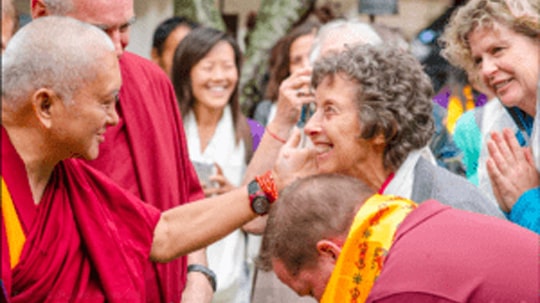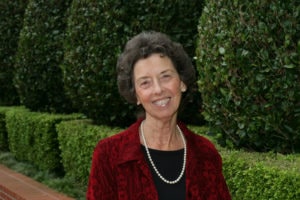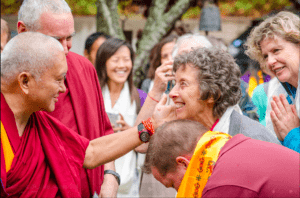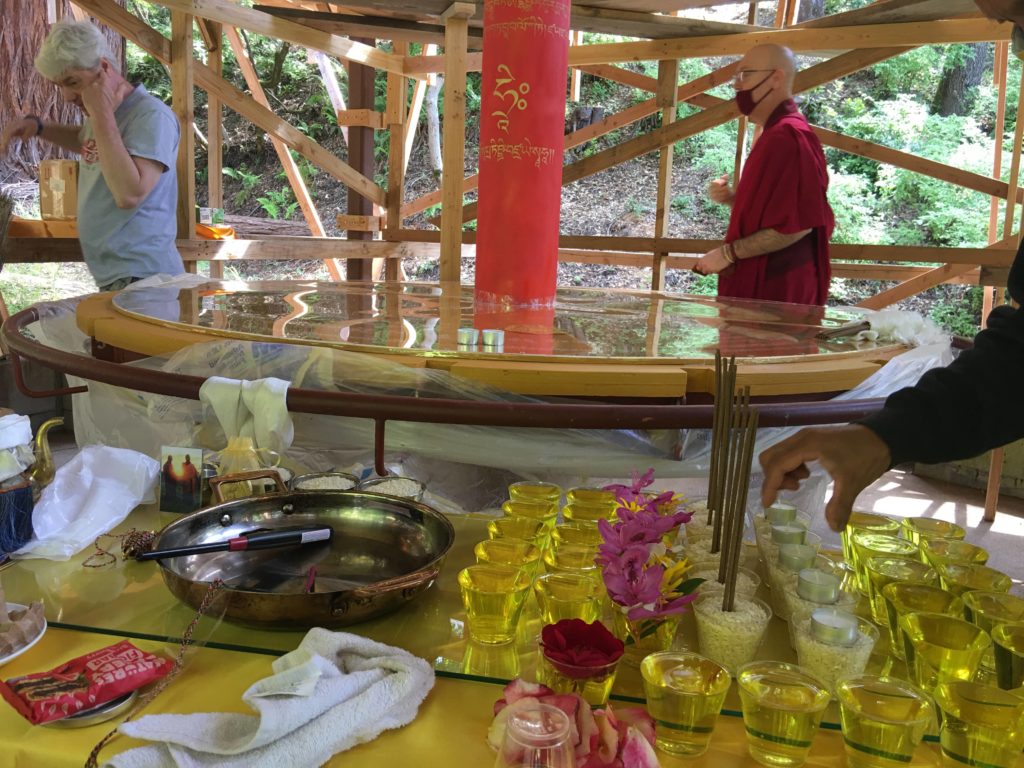
16 Dec What Are the Three Things A Dying Person Needs from You Most?
An Interview with Lennie Kronisch
by Catherine Slocock-Graham
Death is such a “depressing” scenario. Why even talk about it at all? Most of us would rather keep the skeleton tightly tucked away in the closet and pass the time thinking about something “a bit more positive”. But no! Stop! That, right there, is the nub of the problem. Retreating into denial of death may appear to be the comfortable option, but it deprives us of much

Lennie, on the occasion of the ‘Unsung Heroes of Compassion’ ceremony in San Francisco, November 2005
more than we can imagine. Death opens a door, and, perhaps even more astonishingly, being ready for death and becoming more accepting of our mortality can bring out life’s deeper sweetness and an appreciation of the ‘here and now’.
Lennie Kronisch has had ample opportunities to take the plunge into these challenging yet paradoxically rewarding waters and en route, she has gained a wealth of understanding. Though Lennie is known to many of us for her Buddhism-related activities, (firstly as an early member of the Vajrapani Institute community and also as founder of the Tara Home, Soquel, a project for dying individuals in the last months of their process) it was before her Buddhist days, back in 1976, that her interest in the field was first sparked. The big turning point came at a conference in San Diego when she had the good fortune to encounter one of the great pioneers of the conscious death and dying movement, Elizabeth Kubler Ross.
Not long after this first meeting, Lennie was commissioned to interview Elizabeth Kubler Ross for Yoga Journal. Lennie recalls that this fueled her fascination with Kubler Ross’ approach so much that she began integrating aspects of the luminary’s work into her life. “Elizabeth Kubler Ross coined the term ‘little deaths.’” she explains. “She likened every loss you go through, every heartbreak or grief, your house burns down or whatever, to a little death. This was before I was a Buddhist, but really it’s letting go of attachment to whatever it is. Her point was that each one of these ‘little deaths’ transforms your psyche and your psychology so that you are preparing for the letting go of the body that happens when death comes.”
Years later, an intense patch in Lennie’s personal life presented her with a deeply practical phase of learning about death and dying: she suffered a succession of four losses in just a year and with most of them, played an active role in the care process. The first of these was the passing of Diney Woodsorrel, the first wife of George Galt. (George is a Vajrapani Institute founder and currently Chair of our Board.) Lennie was part of a team of friends who moved in

Lennie receives a blessing from Lama Zopa Rinpoche
and took care of Diney in her last weeks. “Then in January 1984, my mother died of a first fatal heart attack. I was there when it happened… A couple of weeks afterwards, I got a call asking me if I would come and take care of Lama Yeshe. He had just moved into the house in Aptos. That was during his final illness. I went, and I was part of a team of three nurses taking care of him around the clock… It was simply amazing to combine my nursing education and experience with the Buddhist practices.” Six months after this life-changing experience, Lennie was contacted by an uncle in Florida. Her aunt was dying of a brain tumor. “I had very ‘hands-on’ care for the week until she died. I helped her die peacefully.”
Dying peacefully, according to Tibetan Buddhist belief, is incredibly beneficial. Death is considered pivotal. For advanced yogis, the transition of death even represents a chance at the highest spiritual goal of all. For the rest of us, a good death gives us a smooth take-off into the next life. So the big question is, how do you help someone die peacefully?
Simply put, Lennie’s answer to this has three elements: a kind heart; the quality of presence and an ability to meet someone where they are at. “The Hospice definition of presence,” she says, “is the ability to be present with suffering, without trying to fix it, change it, distract from it, (like make a joke) .. to just be with what the person’s going through. That’s the number one requirement, after a kind heart,” she adds.
“As you know, many people feel awkward around death… People don’t know what to say; they feel scared; they feel threatened by their own mortality. It’s too close to home. In our Western society, in general, thoughts and conversations about death are pushed far away for as long as possible. It’s underground … There’s not a connect. We haven’t accepted it as part of our everyday reality….Part of Lama Zopa Rinpoche’s advice for Tara Home is that people die every minute. We turn it into a tragedy, but actually it is not so special.”
“Also, it’s very important not to lay one’s own trip on an unwilling person at the time of death”…. she continues. “When you’re with someone who is dying, what you need to do is attune yourself to their way. Many people, when they know they’re facing death, even if they’ve been lapsed religiously all their life, go back to, for example, wanting a priest to visit, having the bible read to them and so on. What is skillful, and this comes straight from Lama Zopa, is to use their language, like Mother Mary or Jesus and to talk about things that are universal, like the Light, Peace and Peace of Mind.”
In 1990 Lennie’s perspective on death shifted once again. This time, she herself had a brush with her mortality, in the form of a cancer scare. She sent word to Lama Zopa Rinpoche to request prayers. “A message came back that there were serious hindrances to my life and that I needed to get into retreat immediately and do a very long, elaborate retreat. As it happened, I was on the verge of leaving for six months in Australia… I was all prepared to go. I canceled and went into retreat… I think that was the first long solo retreat done on the land at Vajrapani.”
It was soon after this, in 1991, that Lennie started her first job as a Hospice Nurse. The development was deeply aligned with the spiritual work she had just done. In particular her retreat had helped her make significant leaps in terms of her capacity for renunciation and letting go of longing desire in general. “It opened up something in me and I let go of something big…. “It all comes back to letting go,” she continues. “That is renunciation… There are many opportunities to let go and they are all practices for the big letting go, if you allow yourself to go through the experience and don’t distract yourself, or block it or push it back down where it can lurk in the mud… If you allow yourself to go through the experience of the pain and the suffering, it’s purifying. With purification, it moves out of you and then you have spaciousness.”
Lennie’s Hospice position was as a primary care nurse, visiting the homes of dying people, caring for them as well as providing emotional support to the families and teaching them how to be around a dying person. She witnessed many deaths and as a meditator and spiritual practitioner, was able to draw inspiration from her constant exposure to the stark realities of our human frailty. She was also able to channel the fruits of her meditation practice into her ‘holding of the space.’ “You can change the energy in a room just by your calmness,” she explains.
For seven and a half years Lennie continued working for Hospice and it is a period she remembers with great fondness, describing it as the most meaningful and fulfilling nursing job of her career. Her expertise later found expression in a more overtly spiritual guise when she went on to co-found Tara Home, a volunteer-run non-profit that houses and provides end-of-life care and Buddhism-inspired spiritual support to one individual at a time throughout their last months. Lennie and Vajrapani Institute’s current resident teacher, Venerable Tenzin Chogyki, both had the idea for the project at around the same time, and worked together closely during its inception.
Tara Home opened its doors to its first resident in 2002 and since then has served a total of 42 dying individuals. Sadly, at the time of writing, the project is itself in something of a state of transition: a dwindling volunteer pool and resources mean that it is seeking to shift to a more viable modus operandi. The project has enjoyed its high points, however, perhaps the sweetest moment being when Lennie was personally acknowledged by His Holiness the Dalai Lama at a ceremony in November 2005 in San Francisco. At the event, 50 people from around the world were each individually honored with the title ‘Unsung Hero of Compassion’ for their work to benefit others; establishing Tara Home was Lennie’s contribution.
For a dedicated Tibetan Buddhist such as Lennie, public praise from none other than His Holiness must have been an exceptionally precious experience, possibly almost a moment of overwhelming magnitude. It is perhaps for this reason, or out of modesty, that she failed to even mention this detail at the time of our interview. Whatever her reason, the fact remains that her contribution has been of the deepest value and deserves to be brought out of the closet, just as much as the skeleton of Death does! With this thought in mind, it feels appropriate to close with an observation from Lennie about the benefits of confronting our mortality and ‘doing the work’ while there is still enough time in hand:
“If you work on yourself during your life and you fully experience what your experiences are and deal with purifying your garbage, then little by little by little, you become more fearless. That’s how your mind and life open up and you become happier, more content, so that when death comes, you can ease on down the road.”
Vajrapani Institute’s Resident Teacher, Venerable Tenzin Chogkyi, will be leading a “Peaceful Living, Peaceful Dying” Retreat here from November 30th to December 3rd, 2017. For more information and to register visit: http://www.vajrapani.org/retreat/peaceful-living-peaceful-dying/
For more information on Tara Home, check their website.




